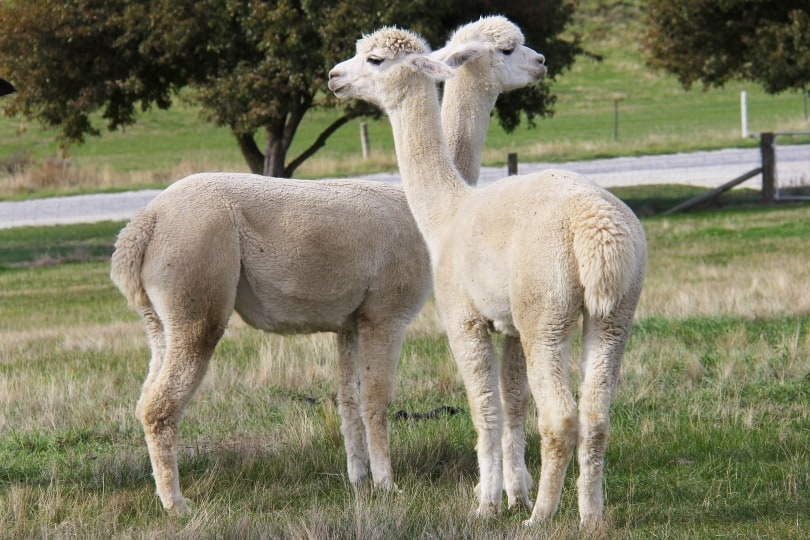Llamas are docile, quiet animals, and while they are not outwardly vocal creatures, they do have their own unique form of communication. If you’ve ever spent any time around llamas, you’ll likely have noticed the low humming sound they use, often likened to a cat purring or even a person humming. But llamas are capable of some other interesting vocalizations too.
If you’ve ever wondered what llamas sound like and how they communicate, you’ve come to the right place. Read on below to find out more!

The 6 Types Of Llama Sounds
Here are all of the various sounds you’re likely to hear a llama make:
1. Humming
The most common of all llama vocalizations, llama humming is a relaxing and peaceful sound, often referred to as “morning humming” as they typically make this sound in the morning. Llamas will make this sound when they feel comfortable, safe, and relaxed, and it can sound very human-like at times.
Llamas also purr at times, a sound very similar to humming, and is also an indication that your llama is happy and content. Cats are not the only animals that purr, and it’s easy to mistake the purring of a llama with that of a cat!
2. Grunting and Grumbling
Llamas also emit a grunting sound occasionally, most often when they’re hungry. They may also grunt when they feel uncomfortable, and this could indicate that they have pain or digestive discomfort of some kind.
3. Snorting
Llamas will again snort or sneeze when they feel uncomfortable, or possibly when they’re about to spit! They may simply have an itch in their nose, or they are feeling slightly threatened and letting you know they want their space. It’s important to watch your llama’s body language as well as the sound they’re making to really understand what they’re trying to say.
4. Alarm
Llamas are commonly used to guard sheep flocks for farmers, and when you hear their alarm sound it’s easy to understand why! The call sounds almost like a high-pitched neighing horse and is a sure sign that the llama feels threatened by something. Llamas will often make this sound before spitting, so be sure to steer clear! If you have a herd of llama around other animals and you hear this sound, it’s best to pay attention as there may be a predator nearby that your llama is trying to warn you of.
5. Screaming
Llamas also produce a loud, high-pitched, and somewhat disturbing scream that can sound very much like a human at times. There are various reasons for llamas producing this sound; fear, pain, or even if they feel threatened, and so it’s a sound you’ll want to pay attention to and respond to immediately.
6. Orgling or Mating call
Similar to grunting, llamas make an orgling sound when in heat or looking for a mate. It’s similar to both grunting and snorting but a fair bit more intense and somewhat longer. Sometimes, llamas will also scream during mating season, which usually begins in January and lasts about 3 months.

How Do Llamas Communicate?
Llamas communicate using all of the above-mentioned sounds, most commonly humming or grunting. While llamas are capable of several unique vocalizations, they use these sounds in different ways in different situations. For example, llamas will grunt when they feel unhappy or uncomfortable, but can also grunt a lot during the breeding season while looking for a mate and may even scream during this period too—although a scream is typically used as an alarm call.
This is why it’s important to take note of a llama’s body language as well as their vocalizations when trying to understand them more deeply. Look for signs like pulled-back ears and stamping feet, these are sure signs that a llama is unhappy and should be left alone. If your llama seems calm and is very still and relaxed, emitting a gentle humming sound, they are likely in a good mood and happy to be approached.

Do Llamas Spit?
Yes! Just like their close cousin the camel, llamas won’t hesitate to spit if they feel annoyed or threatened. Female llamas spit to let a male know she’s not interested during the breeding season, and males and females spit to keep others away from food.
Final Thoughts
Llamas communicate in a variety of ways, and the sound you’ll hear coming from them the most is a calming, soothing humming sound. They also grunt, snort, and even scream at times, although these sounds are usually reserved for when they feel threatened or during the breeding season. Communication is not reserved solely to sounds, though, and body language is also an important method of communication. Typically, a pulled-back head, an upward-pointed chin, and stamping feet are sure signs to steer clear!
Featured Image Credit: Piqsels
